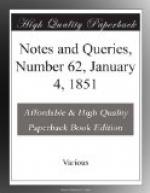“And though some rebels bear the picture of the five wounds painted, against those who put their only hope of salvation in the wounds of Christ ... and though they do bear the image of the cross painted in a rag ... yet let no good and godly subject ... follow such standard-bearers of rebellion.”
Again: just before the quotation cited by L.S. {9} is an allusion to the “defacing or deformation” which the rebels have made, “where through they tarry but a little while they make such reformation, that they destroy all places, and undo all men where they come.”
Collier, in his Eccles. History, vol. vi. p. 469. edit. Straker, 1840, part ii. b. vi., says,—
“However, the insurrection went on, and the rebels made their first march to Durham. And here going into the churches they tore the English Bible and the Common Prayer. They officiated in the service of the mass, had the five wounds of Christ represented in some of their colours, and a chalice in others. One Richard Norton, an ancient gentleman, carried the standard with a cross in it.”
In this passage we have three out of four facts enumerated: 1st. The defacing of places; 2d. The banner with the five wounds; 3d. The standard with the cross. It does not, therefore, seem unreasonable to infer, that the other fact alluded to, viz. the banner with the motto, is to be referred to the same rebellion.
It is not, however, impossible that the rebellion, which broke out A.D. 1549, first in the western counties, and then in Oxfordshire, Bucks, Norfolk, Suffolk, and Yorkshire, may be also alluded to in the homily. For Cranmer, in his answer to the Devonshire and Cornish rebels, urges this amongst other reasons:—
“Fourthly, for that they let the harvest, which is the chief sustentation of our life; and God of his goodness hath sent it abundantly. And they by their folly do cause it to be lost and abandoned.”—Strype’s Mem. of C., ed. Oxf. 1840, vol. ii. p. 841.
An argument similar to the one used in the homily.
The insurrection, in fact, in the midland and north-eastern counties, began with an attempt to redress an agricultural grievance; according to Fox (E.H. vol. ii. p. 665. edit. 1641); “about plucking down of enclosures and enlarging of commons.” The date of the homily itself offers no objection; for though it is said (Oxf. ed. Pref. p. v.) not to occur in any collected edition printed before 1571, yet there exists a separate edition of it printed in 4to. by Jugge and Cawood, probably earlier than A.D. 1563. Collier does not quote his authority for the statement about the banners, but probably it was either Camden or Holinshed, and a reference to these authors, which I regret I have no means of making, might established the particular point in question.
E.A.D.
* * * * *




